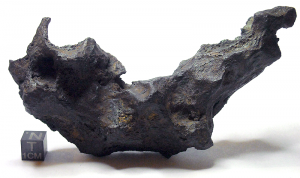Setting the Right Expectations: Getting an Expert Opinion on Your MeteoRite or MeteorWrong

Like almost all online meteoriteWork in progress. A solid natural object reaching a planet’s surface from interplanetary space. Solid portion of a meteoroid that survives its fall to Earth, or some other body. Meteorites are classified as stony meteorites, iron meteorites, and stony-iron meteorites. These groups are further divided according to their mineralogy and Click on Term to Read More hunters, collectors, dealers and research institutions, SkyFall receives many emails a year from people wanting us to evaluate their specimens and determine if what they have is a meteorite or a meteorwrong. Most people are polite and thankful for the free expert opinion. Unfortunately, a subset of inquiries come from people who, for various reasons, are emotionally invested in the specimen being a meteorite. Some want to continue believing in a family myth because the specimen in question was handed down by a family member, whiles other believe they have found a meteorHow long Sonic booms Of the several 10s of tons of cosmic material entering Earth's atmosphere each day, only about one ton reaches the surface. An object's chance of survival depends on its initial mass, speed and angle of entry, and friability (tendency to break up). Micrometeoroids radiate heat so Click on Term to Read More impact craterCrater formed by high-speed impact of a meteoroid, asteroid, or comet on a solid surface. Craters are a common feature on most moons (an exception is Io), asteroids, and rocky planets, and range in size from a few cm to over 1,000 km across. There is a general morphological progression Click on Term to Read More, or even a giant strewn fieldArea on the surface containing meteorites and fragments from a single fall. Also applied to the area covered by tektites, which are produced by large meteorite impacts. Strewnfields are often oval-shaped with the largest specimens found at one end. Given that the largest specimens go the greatest distance, a meteoroid's and think that the specimens collected are worth a fortune. Unfortunately, unless the specimen comes from one of the great deserts (like the Atacama, Gobi or Sahara), there was a recent meteorite fallMeteorite seen to fall. Such meteorites are usually collected soon after falling and are not affected by terrestrial weathering (Weathering = 0). Beginning in 2014 (date needs confirmation), the NomComm adopted the use of the terms "probable fall" and "confirmed fall" to provide better insight into the meteorite's history. If Click on Term to Read More in the area, or it came from a farm where the fields get plowed every year, the chances of the specimen actually being a meteorite are exceedingly small. Please keep in mind that we are not geologists – we cannot always tell you what kind of Earth rock you have. Our responses will be either “Yes, your specimen is a meteorite”, “No, your specimen is not a meteorite” or “Maybe, your specimen may be a meteorite and need to conduct more testing”.
Before proceeding further, you should answer these simple questions.
- Can you accept the possibility that your specimen is an Earth rock and not a meteorite?
- Are you willing to assess the facts and scientific evidence in a clear-headed manner?
- Are you willing to accept the professional opinion of an expert?
Why are we asking these questions? Because, some people will ignore scientific facts and the opinions of experts like ourselves who have handled thousands of meteorites, and they will become belligerent and/or abusive because they need to believe they have “new found” wealth or need to continue believing in that family story. What is worse though is that these people will also waste the valuable time and resources of other experts and scientific institutions until someone, anyone, will validate their claim. e. Some people get upset when you tell them their rock is just that, an Earth rock. In the unlikely event that the rock in question is a meteorite, some people will then insist that their rock is worth a million dollars because of information read on the internet.
The imagined value of something as exotic as a meteorite seems to make people “really, really want” their rock to be a meteorite, and that is completely understandable! If it turns out to be an actual meteorite it’s found money, and found money is really good money because who doesn’t like free money? However, meteorites, like any other collectible, have a wide range of values. For example, could you sell a rusted-out Ford Pinto for $1 M? No, of course not. However, if you found a 1963 Ferrari GTO in someone’s garage and in great condition, then you could sell it for much more as long as the provenance was validated and the authenticity confirmed. If you didn’t know anything about cars, and you found one in a field, you wouldn’t automatically assume it’s worth $1 M. You, like all of us, would hope that it’s worth a lot, but you would not assume it was worth $1 M. Hope is emotional, and some people tend to let their emotions rule over the logical side of their brains when money is involved. A meteorite, similar to a car, is not worth anything until it’s positively identified as a meteorite by a recognized institution and/or meteoriticist.
Our role is to help you determine whether you may have a meteorite and should pursue further authentication and classification. We are here to help you and ultimately save you money because few institutions provide free classification services.
METEORITE FACTS:
- 99.9% of all rocks or pieces of iron which are submitted to experts as suspected meteorites are Earth rocks or man-made byproducts!
- Meteorites are RARELY ever found by novices! Ever… As in almost NEVER.
- Just because a rock sticks to a magnet DOES NOT MEAN IT IS A METEORITE.
METEORITE MYTHS & URBAN LEGENDS:
- Meteorites are NOT radioactive
- Meteorites are NOT hot when they impact the ground (not typically)
- Meteorites don’t make craters (unless they’re really really big)
- Meteorites don’t make screeching or humming noises
- Meteorites don’t attract other rocks
- Meteorites don’t have HOLES (as a rule)
So what is a Meteorwrong? Well, it’s NOT a Meteorite.
Seriously, there are literally thousands of Meteorwrongs for every 1 verified and identified Meteorite that is found. The ratio is actually more than 99.9%. Here’s a VERY good website that will show you in full color what many of the Meteorwrongs look like. The Gallery of Meteorwrongs This site is run by Dr. Randy Korotev a lunar geochemist who studies lunar meteoritesAchondrite meteorites from the surface of the Moon. Most were found in the hot deserts of northern Africa and Oman and others were found in the cold desert of Antarctica, although one, a 19-gram specimen, was recovered in 1990 from Calcalong Creek, Australia. These stones are of great importance because, Click on Term to Read More. He’s an expert in his field. The photos of all the MeteorWrongs are numerous, many are very convincing to the untrained eye.
It’s important to realize that just because some rocks pass the online tests, it’s always a good idea to have someone who is experienced with meteorites help you identify your rock.
Meteorite Identification: Think You Found a Meteorite?
FIRST: Go through and read ALL the information above. If you’re still convinced you have a meteorite, feel free to send me photos.
Please send clear and sharp photos. I’ll take a look at your stone and give you my unbiased experienced opinion. Keep in mind, meteorites are VERY rarely ever found, and 99.9% of ALL suspected meteorites are Earth rocks, or “MeteorWrongs”. Don’t be surprised if what you have is terrestrial. If it’s a meteorite, I can refer you to a lab to get it classified, and I might be interested in buying it or helping you sell it to one of my many meteorite collector clients.
Also check out MeteoritePhotos.NET a great Meteorite Photo site with lots of meteorite photos to help you learn about what meteorites look like. Or send me an email using the contact form






